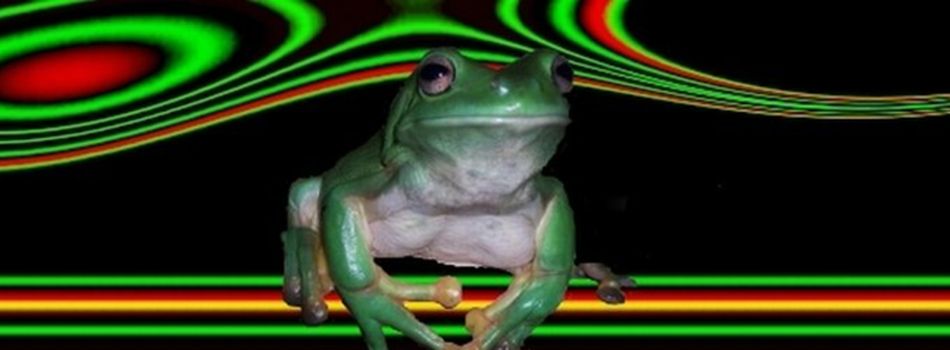The Australian green tree frog (Ranoidea caerulea, formerly Litoria caerulea) does not undergo true hibernation like mammals, but instead enters a state of torpor or brumation during colder or drier periods. This adaptation allows the frog to survive when environmental conditions are unfavourable, such as during winter or extended dry seasons.
What Triggers Dormancy?
-
Temperature Drop: As temperatures fall during winter, green tree frogs become less active and seek shelter to conserve energy and moisture.
-
Dry Conditions: In arid or dry seasons, they also reduce activity to avoid dehydration, using behavioural and physiological adaptations to retain moisture.
Where Do They Go During Winter or Dry Periods?
-
Sheltered Hiding Spots: Australian green tree frogs spend the day and periods of torpor in cool, dark, and moist refuges such as:
-
Tree hollows
-
Rock crevices
-
Under bark
-
In and under logs
-
Under rocks
-
Occasionally in human structures like bathrooms, drain pipes, and garden pots
-
-
Burrowing: In particularly dry periods, they may burrow into soil or leaf litter to escape desiccation and extreme temperatures.

Physiological and Behavioural Adaptations
-
Torpor/Brumation:
-
The frog’s metabolism slows significantly, reducing energy and water requirements.
-
They remain largely inactive, only emerging when conditions improve.
-
-
Moisture Conservation:
-
Their skin secretes a waxy coating to reduce evaporative water loss.
-
They may envelop themselves in a cocoon made of shed skin and mucus to further prevent dehydration during extended dry spells.
-
-
Hydration Strategies:
-
Australian green tree frogs can absorb condensation and moisture directly through their skin, especially from cool surfaces or during humid condition.
-
They use a “wiping” behaviour to spread hygroscopic (moisture-attracting) secretions over their skin, enhancing water uptake and retention.
-
- More Strategies:
-
Lowered Body Temperature: Their body temperature drops to near ambient levels, sometimes as low as 1.5–7°C (35–45°F), greatly slowing metabolism.
-
Reduced Heart and Breathing Rates: Heart and respiration rates can decrease by more than 50%, minimizing energy and oxygen needs.
-
Suppressed Immune System: Immune function is reduced, making frogs more vulnerable to infections during and immediately after brumation.
-
Behavioural Dormancy: Frogs remain motionless and hidden, only emerging when conditions improve in spring or after rain.
-
Duration and Emergence
-
Seasonal Timing:
-
The period of torpor typically coincides with the coldest or driest months, varying by region and local climate.
-
Frogs resume normal activity when temperatures rise and/or rainfall increases, often emerging at night to feed and, in the wet season, to breed.
-
Risks During Dormancy
-
Extreme Cold or Heat:
-
While green tree frogs can tolerate moderate drops in temperature, exposure to prolonged extreme cold or heat can be fatal.
-
-
Dehydration:
-
If unable to find sufficiently moist refuges, frogs risk desiccation during dry periods.
-
-
Predation:
-
While hidden, they are less vulnerable, but if shelters are disturbed, they may be at risk from predators.
-
Captive Care Note
-
In captivity, it is best to keep enclosures at a stable, warm temperature (24–27°C) year-round. Allowing temperatures to drop significantly can stress the frogs and make them susceptible to infection or other health issues. If kept cooler, feeding should be reduced, as their metabolism slows and they will eat less.
Summary Table: Australian Green Tree Frog Hibernation
|
Aspect |
Details |
|---|---|
|
Dormancy Type |
Torpor (brumation-like state), not true hibernation |
|
Triggers |
Cold temperatures, dry conditions |
|
Shelter |
Tree hollows, rock crevices, under bark/logs/rocks, burrows, human structures |
|
Adaptations |
Metabolic slowdown, waxy skin secretion, cocoon formation, moisture absorption |
|
Duration |
Coldest/driest months; resumes activity with warmth/rain |
|
Risks |
Extreme temperatures, dehydration, predation if disturbed |
|
Captive Care |
Maintain stable warmth; avoid prolonged cold; reduce feeding if less active |
In summary:
Australian green tree frogs survive winter and dry periods by entering a state of torpor in moist, sheltered locations. Their bodies slow down, they conserve water with skin secretions and cocooning, and they rely on their ability to absorb moisture through the skin. This dormancy is temporary, with frogs becoming active again when conditions improve.
